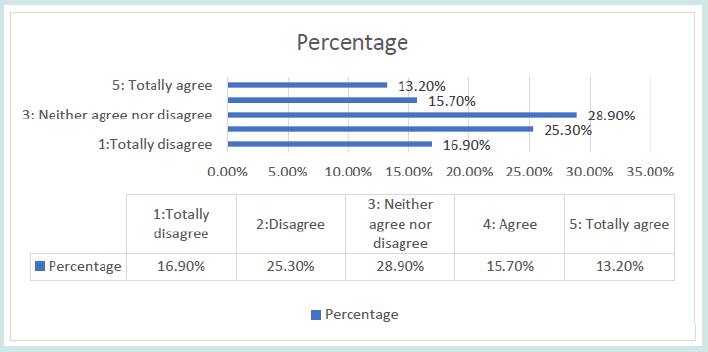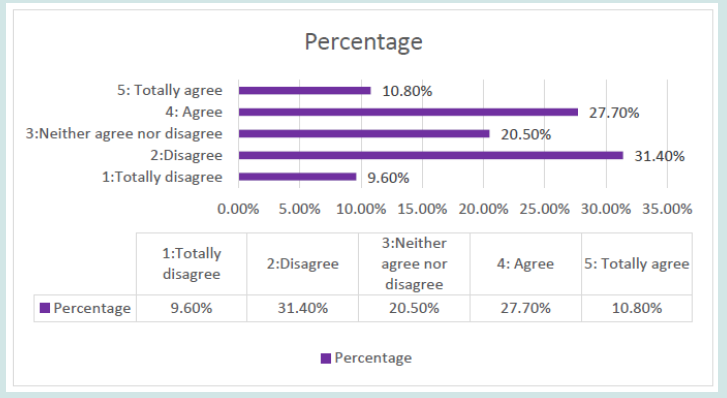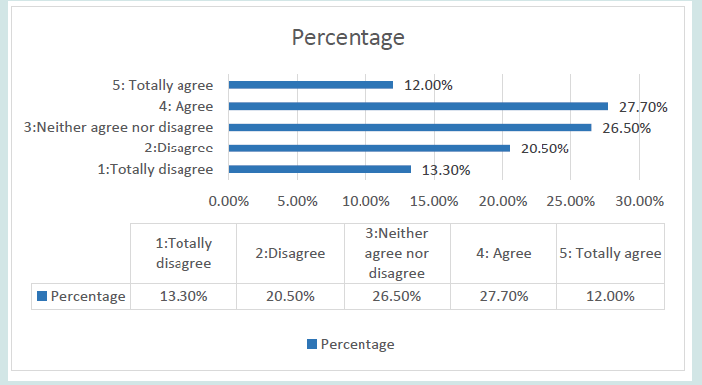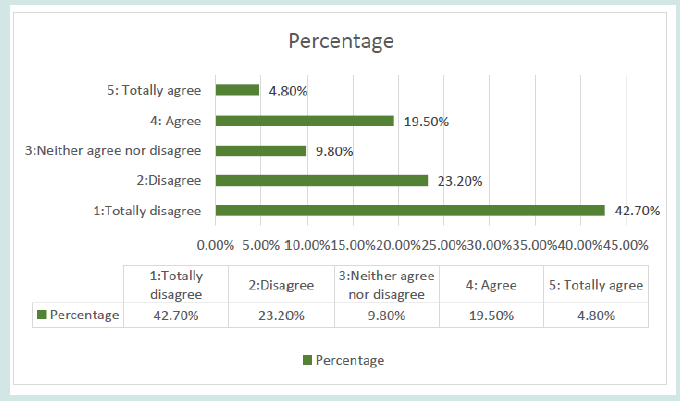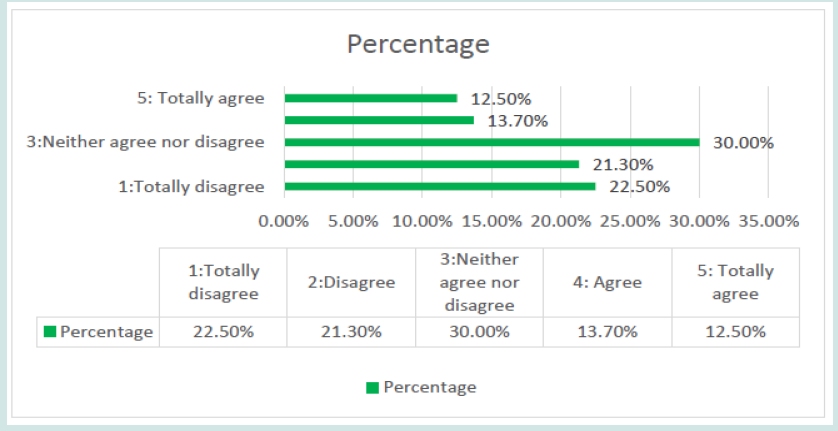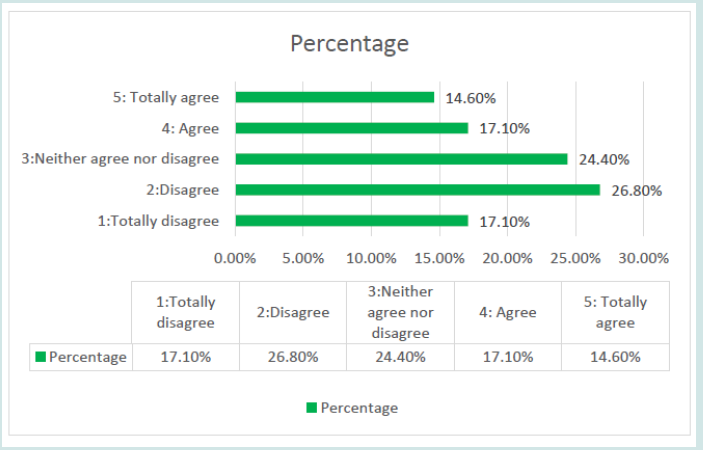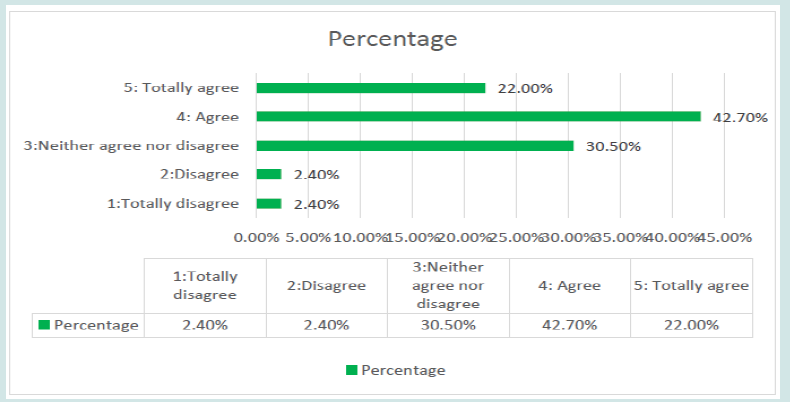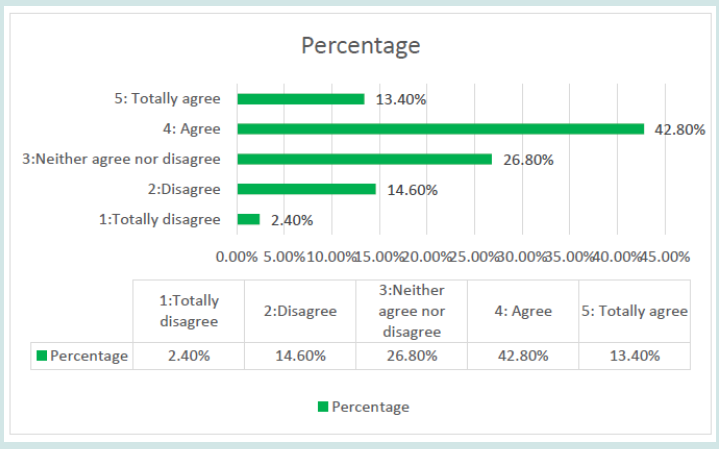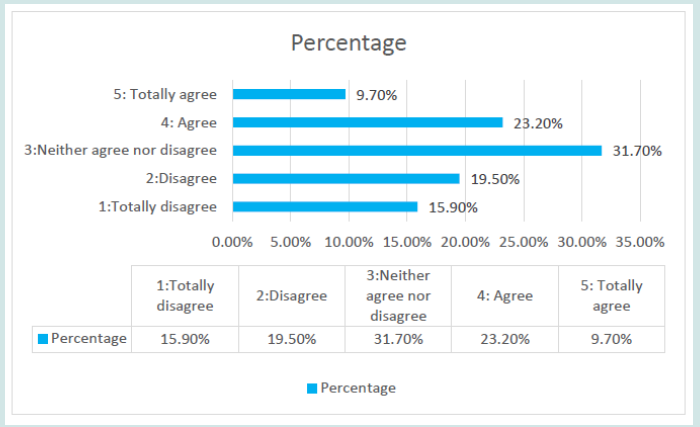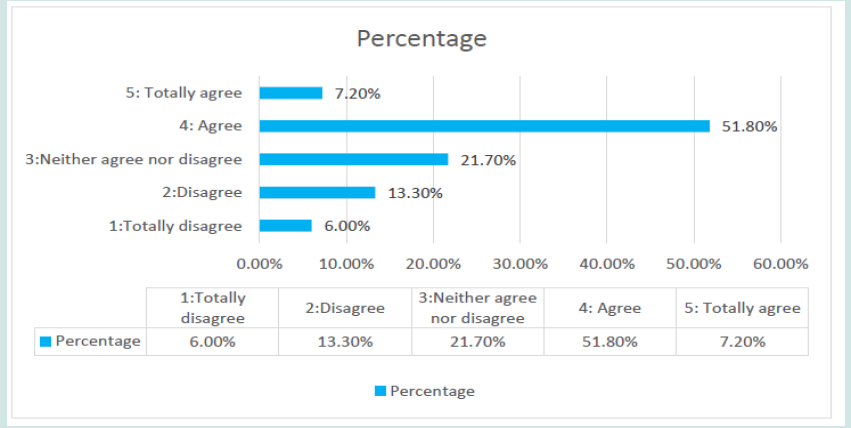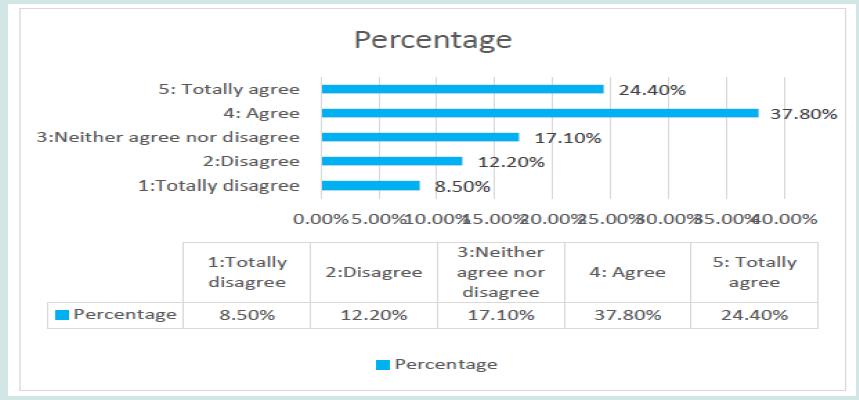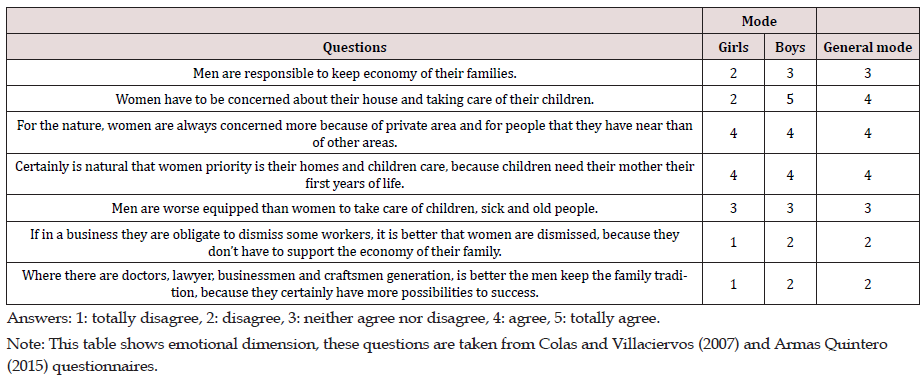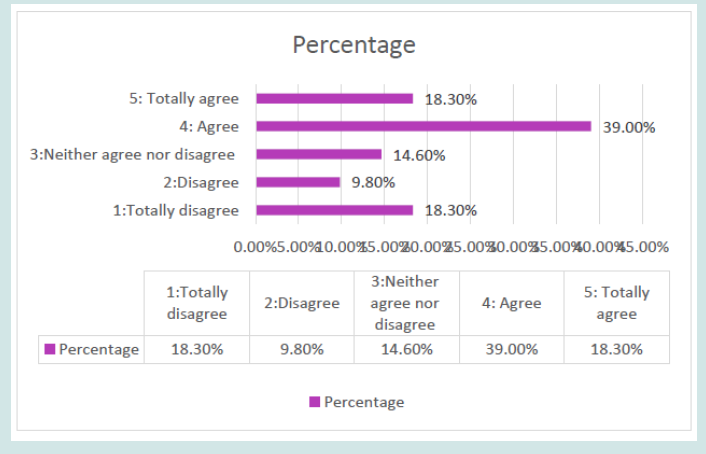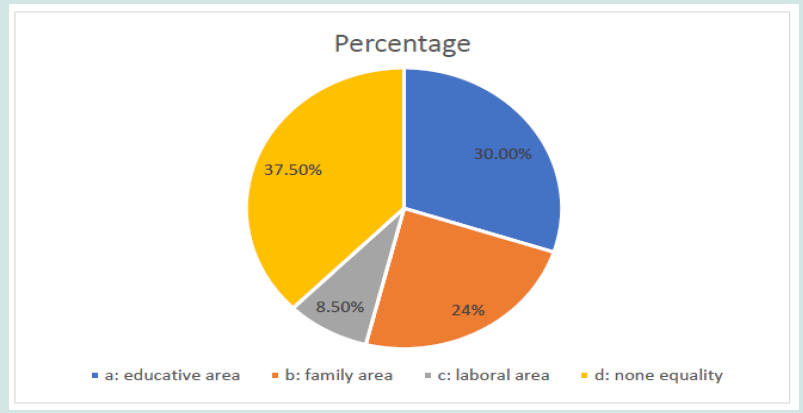
Lupine Publishers Group
Lupine Publishers
Menu
ISSN: 2690-5752
Research Article(ISSN: 2690-5752) 
The Inequity of Gender Roles in Ecuadorian Family, Perspective of Teenager and Comparison Between Girls and Boys, As First Step to Design of a Training Program to Prevent Gender Violence Volume 7 - Issue 2
Rosa Navas Espinosa Msc. Ph.D. 1* and Guojian Ma Phd.2
- 1Magister in Cognitive and Learning Psychology FLACSO, Argentina. Studying a Ph.D. in Science of Management and Engineering at Jiangsu University, China and an academic coordinator at English Ride
- 2Ph.D. in Science of Management and Engineering at Jiangsu University, China. Professor at Jiangsu University and a thesis supervisor
Received:July 05, 2022 Published: August 25, 2022
Corresponding author:Rosa Navas Espinosa Msc. Ph.D., Magister in Cognitive and Learning Psychology FLACSO, Argentina. Studying a Ph.D. in Science of Management and Engineering at Jiangsu University, China and an academic coordinator at English Ride
DOI: 10.32474/JAAS.2022.07.000256
Abstract
Gender inequality is an issue worldwide, also it is related to gender violence. So, studying inequality of gender roles in Ecuadorian families according to teenagers’ views is an important topic, in order to understand the problem and generate possible solutions to prevent gender violence. The development of equality in families and society is the key to reduce violence. For that reason, in this study, the main objective is to analyze the perceptions of inequality in gender roles in teenagers that live in Ecuador by applying a psychometric test that was validated. This test also gives information on seven dimensions of inequality in gender roles. This group provides information about gender roles, in addition, it compares boys’ and girls’ answers. In Ecuador, women and men have different roles, there is a marked difference between gender roles, and in addition, there is not enough research about inequality. Therefore, this study contributes more information and gives us a specific problem to lead following research. As a result, there is inequality in gender roles, women are supposed to take care of children and their tasks in the house, which means the skill dimension is different between men and women. There is significant inequality in the emotional dimension, women can express more of their feelings than men. And also, the group perceived that there is inequality in labor, family educative areas, and other areas.
Keywords: Inequality; Gender Roles; Ecuadorian Family; Teenager
Introduction
In Ecuador there is a gender violence problem against women, there is a high percentage of psychological violence. According to the National Institute of Statistic and Census [1], in a survey about gender violence, it showed that in total 64.9% of women reported an experience of violence. The 56.9% reported that they experienced psychological violence, then 47.5% of women reported obstetric gynecology violence. In addition, the 35.4% of women reported physic violence and the 32,7% reported an experience of sexual violence. In a less significant percentage, 16,4% reported economic and patrimonial violence. In teenager is different because they have a high percentage in sexual violence. According to Healthy Pan-American Organization [2] 21% of children and teenagers had suffered sexual violence in Ecuador. Most of the gender violence is related to chauvinist and sexist thought, a normal family in Ecuador has rigid gender roles between women and men, that generate inequality. Women and girls have to behave in a different way of men, so they have to be less independent, stay at home and be dominated by men.
In 2020, Ecuador had a gender gap of 72%, the country is located in 24th position of the ranking in inequality of gender, and it includes 153 countries. That means that there are differences between boys and girls, in the index of inequality of roles gender (Macro Data of Ecuador) [3]. According to United Nation Organization focus on Women [4] Ecuador is a country that has a lack of gender roles equality and women’s right. The inequality in gender roles, politic violence and gender labor distribution lead to women and girls to participate less in politics and leadership activities in comparison of men and boys. Another unequal data is that in 2013 the month salary in rural areas in women was 219$, in contrast men earned 293$. In urban area, women earned 421$, and men earned 524$. Women worked 15 hours with 45 minutes more than men, and they experimented more labor mobility and unemployment than men. In 2014 the 15% of GDP represented unpaid work, this percentage belonged to women [5].
According to Puebla [5] indicated that women in Ecuador have superior education than men. 35, 4% of women have superior education and men have the 17% of superior education. Nevertheless, the salary that women earned has a difference of 25%, they have less salary than men, also only 37% of directives positions are occupied by women. In addition, in white collar occupations that included office tasks, administrative, executive and clerk positions, women earned less than 36,7% of men’s salary. Besides, Solis Beltran, Fernandez Tranquillo, Solis Grande and Teran Puente [6] expressed that gender inequality is very common among women and girls because they are considered an inferior and weak group in society. Gender inequality has a wide impact on society, it generates high risk of violence acts. There is a structural inequality between women and men, consequently, physic, sexual, psychological and economic abuse appear. In Ecuador teenagers in 2020 had reported family violence, there were 79.946 calls to the emergency number 911, and most of the calls belonged to girls (UNICEF, 2021). In addition, violence against women comes from their partners or ex partners [7]. But gender role inequality is the cause of many problems of violence. For that reason, it is fundamental to study inequality and build prevention models focusing on gender inequality. This study includes a test analysis that gives information about the perception of teenagers, and also we compare gender answers.
Theoretical Part
Gender roles are the behavior that a person does according to the cultural and social perception of gender. These perceptions generate specific characteristics for a group, excluding personal skills, necessities, wishes and circumstances. Inequality in social roles in women has devaluate and accept violence against them. There are thoughts that increased inequality in gender roles such us that men are associated with power, domination and organization in a business, in contrast women are associated with subordination, sensitiveness than rationality, those kinds of thoughts generate violence. Social conception is strong and resistant to be modified or eliminated, however, the first step is to be aware of generalization and misconceptions against women [8].
Gender roles have six dimensions: the physic, social behavior, skills, emotions, affective expression and social responsibility. Gender roles are not only related to the behavioral field, but they are also complex and follow some characteristics that are particular in men and women. In the physic dimension, body features are related to women and men that make them different. The second dimension is the behavioral one which includes some characteristics about how men and women have to behave. Inthe skill dimension,there are social abilities that are attributed to women and men. In the emotional dimension, it refers to specific feelings attributed to women and men. In the dimension of affective expression, there are gender roles that allow women to express and show their feelings more than men. At last, in social responsibilities, gender roles divide women and men, women take care of children and people, and men are responsible of scientific, informatics or other jobs, outside home [9]. Then, Armas Quintero [10] added a dimension that refers to general equality and inequality in gender roles. This information is relevant because tests focus on inequality are conformed by these dimensions.
There is information about gender role inequality, according to teenagers’ perspectives of teenagers, children and adults, however, there is not enough research in Ecuador. In the following paragraph there is a background about this topic: In the research of Colas Bravo and Villaciervos Moreno [9], they studied gender roles in teenagers of 14 to 18 years old. They had a sample of 455 students from different educative centers in Seville, 48, 2% were boys, and 51, 8% were girls. They applied a test to know about gender roles focusing on 6 dimensions. This analysis was done in order to build a pedagogic intervention proposal to work toward gender equality. In the result, they acquired that 35% of the sample thought that inequality is related to the physical characteristics between women and men. They believed that there are different behaviors in women and men. In addition, in the questionnaire, most of the sample expressed that girls had to protect and take care of children and also could follow careers in literature. While men were related to techniques and science careers. 20% of the girls’ sample accepted emotional gender roles, in men 40% accepted emotional gender roles.
Armas Quintero [10] studied about gender roles inequality. She applied the test of Cola Bravo and Villaciervos Moreno [9]to 100 teenagers, 47% of the sample were girls and 53% were boys from Laguna, Spain. Ages were from 15 to 17 years old. In results she got the perspectives inequality in gender roles that were significant in six-dimension body perception, social behavior, skills, emotions, social responsibilities and general inequality. In the research was concluded that boys perceived gender inequality. Boys were related with strength, engineering and scientific jobs. In contrast, girls had to take care of children and people who need help, they characterized to be sweet and understanding. The most of boys perceived girls weak and that they could express their emotions. The Women Jaliciense Institution [11] created a manual to increase gender roles equality, they built activities and teaching session to prevent gender violence in Mexico, focusing on the problem of inequality. They have studied different dynamic and participative activities to teach about gender, roles, stereotypes and how to discuss this kind of inequality conception. This model is though in order to be applied in school, where each group will receive two hours a week this kind of information and activities in a semester. The model provide valuable information to design a proposal in violence prevention, but it wasn’t evaluated, it doesn’t have the impact part, that mean that is a group of materials and workshops that could be useful in a program that provide impact of material.
Castillo Mayen and Montes Berges [12] elaborated an adjective scales that evaluated gender roles. The test was applied to 150 participants, 82 were women and 68 men from Spain. In the results, men were related to strength, active, inventive, frankness and guile. Women were associated to sensitivity, loyalty, patience, idealism and warmth. In negative gender roles, men were associated to aggressiveness, competitiveness, dominance, violence and ambition. Women were characterized like fickle, naïve, narcissist, unpredictable and frivolous. they concluded that there were some gender roles that are not prevailing nowadays, likewise perception of gender roles are more equal than in other times, different social factors can change believes and gender roles. In the research of Puebla [5] he made and analysis of gender wage gap in private sectors, using Labor and Business statistic from the INEC, that is the National Institution of Statistics and census. I showed that adults in Ecuador had different salaries depending on the gender. The different in wage is between 1, 9% to 8, 2%. Also women made more precarious work, the average of unconditional salary is higher for women than for men. In white collar jobs men had more job and earned 25% more than women. Most of Ecuadorian women dedicated to take care of their children and to house tasks, they had highest degrees than men, and however men had more jobs than women.
In another research, Ramirez, Manosalvas and Cardenas [13], they study about Latin American women inequality in gender roles and how it affects to school desertion. Inequality in roles is normalize in Latin America. Also, they focused on Ecuador, they expressed that in the country people perceived women as weak, sensitive, and they are submissive. In the research different documents as statistic and questionnaires were analyzed. They concluded that culture and society kept inequality in gender roles. Misconception about gender roles are internalized and for that reason that affects in women school and professional desertion, because they grew up with the idea that they had to take care of children and be at home. Women felt intimidation, because if they studied they didn’t fit in their role that was imposed by society. This limited women education in a negative way, because they didn’t finish school or their university.
Ocaña Lara [14] studied about gender roles inequality in laboral field focused on Latin America. She analyzed 60 documents related to job and gender roles inequality. She did a content analysis of the texts. In the laboral field gender roles inequality was very common. In conclusion salaries were lower in women than in men. Women were associated and involved in precarious jobs or as assistants. Latin American society shared the ideas that women had to take care of children, work in household tasks, and that they can follow jobs as domestic servants, cooks, administrative and other occupations. There were many women with highest degrees, however there were a marked gender role that indicates that men are more skilled. In conclusion discrimination of jobs and opportunities is a problem in Latin American, consequently, it is necessary to transform role gender thought to improve equality.
In the research of Ertl, Luttenberger and Paechter [15] it is a selfconcept with gender roles. The study had a latent regression model base on a survey of 296 women that came from German universities. Also, they acquired more information that had come from a survey they developed, they applied it to students that were part of the project of gender equality, and this group included women and men. The question were related to gender roles, stereotypes, school and family support that are related to self-concept. They concluded that unequal gender roles and lack of family support influenced in a lower self-conception. Gender inequality and stereotypes had a negative impact in self-conception scores. This means that people that perceive a rigid gender roles had a low self-conception.
Eagly, Nater, Miller, Kaufmann, and Sczesny [16] did a metaanalysis that integrated 20,093 adult in United States of America, this analysis extended from 1946 to 2018. Decades has brought changes in gender roles. In the polls they acquired emotional, competences and agency or personality dimension. Over time emotional dimension have been more equal, however in agency or personality dimension there were no change in men expectation, to be ambitious, courageous and dominate. Then competence dimension there were more equality over time, women had gained skills to work as men, they can aces to employment. In Caroli and Sagone [17] they explored in inequality of gender roles associated to toys, traits and jobs. The sample was constituted by 120 Italian college students of the Psychological Faculty in Catania. They used a power point and silhouettes that represented male and female. So, students associated toys, jobs and skills with one silhouette. In the result, they had a high stereotypes levels and also researches perceived high level of inequality in gender roles. There is inequality in toys, traits of men and women. Also, students considered that jobs are different depending on the gender. Women were matched up with dolls, domestic activities, iron and sewing machine, while men were associated to soldiers, locomotive toys, technological and engineering activities. Men silhouette was linked to courageous, intelligent, and organized affirmations. While women silhouette was linked to caring and sensitive affirmations. In conclusion in the researcher they perceived that there was a rigid gender role in young college students.
In other study, Gonzalez Pozuelo [18] proportionated data and an analysis to understand gender roles in Extremadura, Spain, because they wanted to build an intervention program to build equality and violence in gender prevention. The first study that they did was about the inequality in gender roles research. They used a questionnaire of 35 item in 2.642 children. They acquired differences between women and men roles. Children thoughts that women were sweet, understanding and caring. Contrast, men were associated to violence, bravery, organization, dominance and power. Only girls considered themselves more organized than boys and men Also, children answered that women had to care of people and their children, while men were working in a business or in a scientific job.
In Flores Sanchez [19], she studied about school and gender roles in Ecuador. She applied questionnaires, games, and observation methods to understand gender roles in teachers, directives and students. She could analyses how gender roles are transmitted, which speech were used in two Ecuadorian schools. Some teachers that were authoritarian segregated girls and boys and gender roles differences were perceived in their speech. Sometime there are unconscious sexist and chauvinism examples and thought when teacher explain some topics. In addition, students played games following gender roles, girls played with dolls and boys played soccer and with cars. Girls chose profession as vet, doctor and teacher. While most of the boys chose sports, business and military force.in the case of parents, most of them though that girls had to be at home, taking care of their children and that boys were able to follow techniques and scientific jobs to keep their family economy. There are some researches about gender inequality, however in Ecuador there is not enough research material about this topic, also the point of view of teenager provides information to understand their perception about family roles in Ecuador. This can lead other researches in the line of gender equality and violence prevention.
Methodology
This research is a mixed research with descriptive approach. There is information about perspective of inequality in gender roles, the results are descriptive and also are organized using percentages that explained types of gender inequality according to Cognitive Psychology [20]. First, in the theoretical part it is applied the analysis-synthetic method to collect information, this method allows to compare the information that was obtained and then decomposes it, it aims to plan and clarify the problematic situation of the present research work, in this case model to prevent violence and different factors that are involved in violence will be studied. For this it is applied document reviews [21].
Secondly, the next part is to apply a validated test that is called Questioner about internalization of stereotypes and roles of gender by Colas and Villaciervos [9] and Armas Quintero (2015) this is a Likert psychometric test that gives information in percentage about
a) Physic or body dimension
b) Social behavior dimension
c) Skills dimension
d) Emotional management
e) Affective expression
f) Social responsibility
g) General equality and inequality in gender roles.
The scales is 1 to 5, 1 is totally disagree, 2 is disagree, 3 is neither agree nor disagree, 4 agree and 5 totally agree. There are some questions that are about general inequality that have a different scale: never, hardly ever, sometimes, often, and always. The test uses mode, and it gives general percentage and difference in the mode between girls and boys. The population is constituted by teenager of Quito and Guayaquil of three private schools, they preferred to be anonymous. In total there are 83 teenager the 51, 2% are girls and the 48, 8%are boys. The ages are between 14 to 19 years old.
Results
There are seven dimension to analyze, the test is focus on gender difference in answer, because that provides specific information about inequality.
Physic or Body Dimension
(Figure 1) The most frequent answer in the first question about boy attractiveness is number 3: neither agree nor disagree with 36, 1%. Then number 4: agree with 21, 7%. The less significant answers are referring to 5: totally agree with 15, 7%. Then answer number 2: disagree, with 15, 7%. An at last the answer 1: totally disagree: 10, 8% (Figure 2). The most frequent answer is neither agree nor disagree with 3: 28, 9%. Following by the answer 2: disagree with 25, 3%. Then there are less significant percentages in the answer 1: totally disagree with 16, 9%. The answer 4: agree with 15, 7 % and at last 5: totally agree with 13, 2% (Table 1). In the first item, girls disagreed about that men attractiveness is to be robust and vigorous, boys totally disagree with the item. There is not a significant difference between genders in that items. In the second item, girls disagree about the female attractive refers to be fragile and slights. However, according to boys they agree that female attractiveness is to be fragile and slight. In the last part, there is inequality in physic dimension more in boys’ point of view. In the general mode, the group chose 3: neither agree nor disagree.
Social Behavior Dimension
(Figure 3) The 38, 6% answered 2: disagree. Following by the answer 4: agree 28, 9%. Then is the answer 3: neither agree nor disagree with 13, 3%. In the answer 5: totally agree is 12%. Then the answer 1: totally disagree with 7, 2%. (Figure 4) The 31, 4% chose the answer 2: disagree. Then, the answer 4: agree with 27, 7%. The next answer selected was 3: neither agree nor disagree with 20, 5%. The less significant are the answer 5. Totally agree with 10, 8 % and the answer totally disagree with 9, 6 %. (Table 2) In the first question about social behavior, girls and boys disagreed or totally disagree with rudeness showing to society. Then in the second question, there was a significant difference of gender, girls disagreed with the idea to show sweetness and affection, but boys agreed with this idea of showing that they are sensitive. In the general model they chose 2: disagree, that means the most group disagree with social behavior inequality.
Skills Dimension
(Figure 5) The highest percentage is in the answer 4: agree. Then in the answer, 3: neither agree nor disagree with 24, 1%. The next percentage is 2: disagree 20, 5%. At last, the answer 5: totally agree with 14, 5%, and 1: totally disagree: 10, 8 %. (Figure 6) The first significant percentage is the answer 4: agree with 27, 7%. Then the answer 3: neither agree nor disagree with 26, 5%. The next on is the answer 2: disagree with 20, 5%. The less significant are the answer 1: totally disagree with 13, 3%, and answer 5: totally agree with 12%.
(Table 3) In the first question of skills dimension, girls disagreed that women are better in specialties associated in personal care and social services. However, boys agreed with the affirmation and though that girls are better in those professions. In the second question, girls disagreed with the affirmation that boys are better in informatics, electronic, industry and architecture. In contrast, boys agreed that they are better in those professions. The general mode is 4 agree, that means that they perceived skill inequality between women and men.
Emotional Dimension
Figure 7 The significant percentage is the answer 1: totally disagree 42, 7%. Then the answer 2: disagree with 23, 2 %. Following by the answer 4: agree with 19, 50%. At last the answer 3: neither agree nor disagree with 9, 8 %, and the answer 5: totally agree with 4, 8%. Figure 8 The significant answer is 4: agree with 42%. Then the answer 5: totally agree with 25, 9%. The next answer is 3: neither agree nor disagree with 17, 3%. At last the answers 2: disagree with 7, 4 %, and 1: totally disagree with 7, 4 %. Figure 9 The significant percentage is the answer 4: agree with 40, 20%. Then, the answers 3: neither agree nor disagree and 2: disagree got 23, 20%. At last, the answer 5: totally agree got 7, 3%, and the answer 1: totally disagree got 6, 10%.
Figure 10 The significant answer is 4: agree with 47, 6%. Then answer 3: neither agree nor disagree with 28%. The next one is answer 2: disagree with 13, 4%. The less significant answers are 5: totally agree with 6, 1 % and the answer 1: totally disagree with 4, 9%. Table 4 In question number one girls chose 1: totally disagree, they disagreed with the idea that men can’t cry or express emotions in public. However, boys chose answer 4: agree, that means that they agreed with this idea. In the second question, girls and boys agreed that girls cry when they feel pain. Most of the girls selected answer 4. Agree, and boys selected 5: totally agree. In the third question, girls and boys chose answer 4: agree, that means they agreed with the idea that men solve problems using physic strength. In the last questions, girls and boys chose answer 4: agree, they agreed that women solve problems using the dialogue. In the general mode. Most of the sample chose 1: totally disagree, They disagreed with difference in emotional expression between women and men. Both groups agreed that there is a difference in emotional dimension, women can express emotions, and they use dialogue to solve problems. While men uses the strength.
Affective Expression
Figure 11 The significant percentage is answer 3: neither agree nor disagree with 30%. Then 1: Totally disagree with 22, 5%. Then answer 2: disagree with 21, 3%. The next answer is 4: agree with 13, 7%. And at last 5: Totally agree with 12, 5%. Figure 12 The 26, 8% chose 2: disagree. Then the 24, 4% chose 3: neither agree nor disagree. The next percentage have similar answers, answer 4: agree and answer 1: totally agree, both of them with 17, 1%. At last 5: totally agree with 14, 6%. Figure 13 The most significant answer is 4: agree with 42, 7%. Then answer 3: neither agree nor disagree with 30, 5%. The next answer is 5: totally agree with 22%. At last answers 2: disagree and 1: totally disagree got 2, 4%.
Figure 14 The midst common answer was 4: agree with 42, 8%. Then answer 3: neither agree nor disagree with 26, 8%. The next answer is 2: disagree 14, 6%. Then, 5: totally agree with 13, 4%. And at last the answer 1: totally disagree with 2, 4%. Figure 15 The most significant answer is 4: agree with 47, 6%. The following answer is 3: Neither agree nor disagree with 28, 8%. Then 2: disagree with 12, 2%. The next one is answer 5: totally agree 7, 5%. At last, answer 1: totally disagree with 3, 9%. Table 5 In question number one, most of women chose answer number 3 that means that they neither agree nor disagree with the items related to women that can kiss or hug or express their feelings and men cannot. While boys frequent answer was number 4: agree, that means that boys thought that girls are able to hug and kiss in public and men can’t. In question number two, girls chose more answer 2: disagree that means that they don’t agree that women can take their hands and men can’t. However, most of the boys chose the answer 4: agree, that mean that boys though that women can take hand with their friends and men can’t.
In question three, girls don’t agree or disagree with the item that express that women are able to comfort people. While boys agree with that, they though that women can comfort people when they feel sad. In question number four, girls and boys agreed that men are more competitive. Both groups chose answer 4: agree. In question number 5, most of the girls and the boys chose the answer 4: agree. Both groups agreed that women have predisposition to love. In the general mode it shows that most of the sample chose 3, so they neither agreed nor disagreed with the affirmation that women can kiss or hug each other and men can’t. Most of the sample disagreed that women can’t take their hand but men can’t.
Social Responsibility
Figure 16 The significant answer is 3: neither agree nor disagree with 31, 7%. Then the next answer is 4: agree with 23, 2%. Then the answer 2: disagree with 19, 5%. The less significant answer is 1: totally disagree with 15, 9%, and answer 5: totally agree with 9, 7 %. Figure 17 The highest score belong to answer 4: agree with 26, 8%. Then answer 2 with 24, 6%. The answer 3: Neither agree nor disagree got 23, 2%. Answer 5: totally agree got 15, 9%. Finally, the less significant tis answer 1: totally disagree with 9, 7%.
Figure 18 The highest score belongs to answer 4: agree with 51, 8%. Then to answer 3: neither agree nor disagree with 21, 7%. The following answer is 2: disagree with 13, 3%. At last, the less significant answers are 5: totally agree with 7, 2% and the answer 1: totally disagree with 6%. Figure 19 The highest score belongs to the answer 4: agree with 37, 8%. The next dominant answer is 5: totally agree with 24, 4%. Then is the answer 3: neither agree nor disagree 17, 1%. The less frequent answers are: 2: disagree with 12, 2 % and answer 1: totally disagree with 8, 5% percent. Figure 20 The highest score belongs to 3: neither agree nor disagree. Then answer 2: disagree 22%. The next answer is 4: agree 19, 5%. Answer 1: totally agree has 14, 6% and answer 5: totally agree 8, 5%. Figure 21 The most frequent answer is 2: disagree with 36, 6%. Then 1: totally disagree with 31, 7%. The next answer is 4: agree with 15, 9%. Then answer 3: neither agree nor disagree with 14, 6%. And finally, answer 5: totally agree with 1, 2%.
Figure 22 The highest score belongs to 2: disagree with 28, 4%. Then is the answer 1: totally disagree with 24,7%. The answer 4: agree and 3: neither agree nor disagree have the same score 18, 5%. Finally, the answer 5: totally agree has 9, 9%. Table 6 In the first question, women chose answer 2: disagree, they disagreed with the item that is related to men responsibility to keep economy of their family. In contrast boys chose answer 3, they neither agree nor disagree with the item. In the second questions, most of the girls chose answer 2 that means that they disagreed about the affirmation that women can be concerned about their house and taking care of their children. However, boys chose option number 5 that refers that they were totally agree with the affirmation. In question three, both groups chose the answer 4: agree, that means that they agreed with the affirmation that expressed that women are concerned of their private area and people that are part of their life. In question four, both groups chose the answer 4: agree. So, groups agreed with the affirmation that women priority is to take care of their children and house tasks.
In question five, both groups chose with more frequency the answer 3 that means they neither agreed nor disagreed in the affirmation that men are worse equipped than women to take care of children. In question five, girl chose option 1: totally disagree with the affirmation that said in a business if they are obligate to dismiss some workers, it is better that women are dismissed, because they don’t have to support the economy of their family. And boys chose option 2: disagree. Both groups disagreed with this affirmation.
In question 6, the most frequent answer in girls was 1: totally disagree, and boys chose 2: disagree. That means that both groups disagreed with the following affirmation: where there are doctors, lawyer, businessmen and craftsmen generation, is better the men keep the family tradition, because they certainly have more possibilities to success. In the general mode, the group neither agreed nor disagreed with the affirmation that boys are responsible to keep the economy of their family. Most of the groups chose answer 4, they agreed that women are responsible of taking care children and people.
General Equality and Inequality in gender roles
Figure 23 The most frequent answer is 1: totally disagree with 30, 1%. Then the answer 2: disagree with 22, 9%. The next answer is 4: agree with 19, 3%. Then, the answer 3: neither agree nor disagree with 14, 5%. finally, the answer 5: totally agree with 13, 2%. Figure 24 The most frequent answer is 4: agree. Following by answer 3: neither agree nor disagree with 21, 7%. Then the answer 1. Totally disagree with 20, 5%. The next answer is 2: disagree with 18%. At last, answer 5: totally agree with 13, 3%. Figure 25 The most significant answer is 4: agree with 39%. Then answer 5: totally agree and answer 1: totally disagree, both with 18, 3%. The next answer is 3: neither agree nor disagree with 14, 6 %. Finally, the answer 1: totally disagree with 18, 3%.
Figure 26 The most frequent answer was 4: agree with 34, 1%. Then answer 3: neither agree nor disagree with 30, 5%. The next answer is 1: totally disagree with 15, 8%. At last are answer 5: totally agree and answer 2: disagree, but with 9, 8%. Table 7 In the first question, most of the girls chose number 2: disagree, they disagreed with the question that said if you consider we live in a totally equal society as much as women and men. That means they think we don’t live in a totally equal society. Also, boys chose answer 1: totally disagree, they neither think that we are in an equal society as much as women and as men. In the second question, there is a significant difference between groups. Girls chose answer 2: disagree, that means that they didn’t see equality treatment in mass media between women and men. In contrast, boys chose answer 4: agree, the most of them agreed that there is gender equality in mass media. In the third question, both groups chose answer 4: agree, that means that they believed that there is an equal distribution in household task at their home. In the fourth question, both group selected answer 4: agree, so they considered that currently is produced a positive change in quality of women and men.
Figure 27 The most frequent answer is c: laboral area with 68% Then b: family area with 16%. The next answer is d: any inequality with 11, 1%. At last a: educative area with 4, 9 %. Table 8 In this question, both groups chose answer d: any equality. That means that they didn’t perceive gender equality in any area. Figure 28 The 84% of fathers of paternal figures in the sample work. The 16% don`t work. Figure 29 The 55, 3% of mothers or maternal figures work (Table 9). The 41% don`t work. There is a significant different in job are between females and males. Which frequency you do this activities: Order and organize my room. Table 10 In the first question between difference in home task in girls and boys. In the question about the frequency you order and organize you room most of the girls chose 5: always. In contrast boy chose 2: hardly ever. There is a difference in this home task. In the second question, both groups chose 3: sometimes in taking care of someone else.
In the third question, Girls chose often, they often was dishes and set the table. And boy chose 3: sometimes. There is a slight difference. In the fourth question, both groups chose 5: always. Both groups always make bed. In the fifth question, girl chose 5: always, that means that they always clean the table. In the case of boys, they chose 4: often, they often clean the table. There is a slight difference. In the sixth question, the girl chose answer 3: sometimes, they sometimes use the washing machine. In contrast, boys selected the answer 1: never, most of the boys never use the washing machine (Figure 30).
Conclusion
In physic dimension, girls and boys disagreed with men`s attractiveness related to be robust an vigorous. In addition, girls disagreed with female´s attractiveness referred to be fragile and slights. Only boys, agreed that female are attractive because of fragile and slight characteristics. There is inequality in physic dimension, and more in boys’ conception about female physic. In the dimension of social behavior, girls and boys disagreed to show rudeness. Then in the next question, girls disagreed to show sweetness and affection, however, boys agreed with this item. It could be because currently sensitiveness of boys is more accepted in public. In skills dimension, there is a significant inequality, also there are different points of view between girls and boys.
Girls disagreed that women are better in specialties associated in personal care and social services. However, boys agreed with the affirmation. According to the affirmation that boys are better in informatics, electronic, industry and architecture, girls disagreed and boys agreed with this. In emotional dimension girls disagreed with the idea that men can’t cry or express emotions in public. But, boys agreed with this idea. There is a difference between genders in emotional expression. In addition, girls and boys agreed that women cry when they feel pain, likewise, they agreed that men solve problems using physic strength. In the last questions, girls and boys agreed that women solve problems using the dialogue. There is a significant difference between boys and girls in their emotional expression, women can cry, also they solve problems with dialogue. While, boys use strength to solve problems, and according to boys perception they can’t cry. In the affective expression dimension, girls neither agreed nor disagreed with the items related to women can kiss or hug or express their feelings and men cannot. While boys agreed with the item, that means that boys thought that women are able to hug and kiss in public and men can’t. In the question about women can take hands of their friend and men can’t, there was a significant different between girls and boys. Girl didn’t agree with this unequal affective expression, however boys agreed with the idea that women can take their hands, but men can’t. In the next item girls neither agreed nor disagreed with the affirmation that women are able to comfort people. While, boys agreed with that, they though that women can comfort people when they feel sad. That means that in this dimension boys perceived more inequality. In the last questions boys and girls agreed that men have a competitive attitude and girls have a predisposition to love. That means that both groups accepted there is a different expression in gender roles.
In the social responsibility dimension, there is more inequality in women’s responsibilities. Women disagreed with the idea that men are responsible to keep the economy of their family. While boys neither agreed nor disagreed with that item. In the question about women are concerned in their house and taking care of their children, girls disagree, however boys totally agree with the affirmation. That means that most boys though that women are responsible of their house and children. In other question both groups agreed that women are concerned in the private area and people that are near them. Also, both groups agreed that women’s priority are their children and house tasks. In the next question both groups disagree with affirmation that said that men are a support of their family, so is better to dismissed a women in a business, likewise, they disagreed with the idea that men have to follow the family tradition of being a doctor, lawyer, business and craftsman, because they have more success.
In general equality and inequality dimension, Girls and boys disagree with the affirmation that we live in an equal society. In the question about mass media, girls disagreed about and equal treatment in mass media. However, boys agreed with that affirmation and didn’t perceive inequality in that area. In the next question, both groups thought that they had an equal distribution in house hold tasks at their home. Also, they perceived positive changes in equality between women and men. Both groups perceived more gender inequality in laboral area. They express that they didn’t perceive an equality in any areas, such as familiar, laboral, educative and another areas. Another information was that the 84% men, fathers or paternal figures in the sample work, however in the case of women, mothers or maternal figures, only the 55, 3% work. In addition, in home task, there is inequality in some items, most of the girls always organize their room, clean the table and sometime use the washing machine. In the groups of boys thy hardly ever organize their room, they often clean the table and never use the washing machine. In some aspects both groups had a similar answer, like that they sometime take care of someone else. They always make their bed.
References
- (2019) National Institute of Statistic and Census. Survey of violence against women. INEC.
- (2021) Pan American Health Organization. Violence against children and teenagers in Ecuador, OPS.
- (2020) Macro Data of Ecuador. Global index gap of gender inequality in Ecuador.
- (2022) United Nation Organization focus on Women. ONU Women, Ecuador.
- Puebla D (2018) Wage gaps by gender with an occupation and company size: decomposition by quantile. Analytic magazine 16(2): 71-115.
- Solis Beltran GL, Fernandez Ronquillo MF, Solis Granda LE, Teran Puente CF (2018) Gender inequality in educational processes that affect in violence against women. Podium p. 33.
- Esteves Pereira M, Azeredo A, Moreira D, Brandao I, Almeida F (2020) Personality characteristics of victims of intimate partner violence: A systematic review. Aggression and Violent Behavior 52(1): 1-11.
- Cook R, Cusack S (2010) Gender stereotypes: transnational legal perceptive. University of Pennsylvania Press, Philadelphia. Berkeley Journal of Gender, Law & Justice (Profamily 1st edn) p. 11-53.
- Colas Bravo P, Villaciervos Moreno P (2007) Internalization of gender stereotypes in teenagers. Educative Investigation Magazine 25(1): 35-58.
- Armas Quintero A (2015) Teenager perception about gender stereotypes. Bachelor Thesis. Social Work Faculty, Laguna University, Laguna, Philippines.
- (2008) The Women Jaliciense Institution. Women and men, what different we are? gender sensitiveness manual. Women Jaliciense Institution Editorial.
- Castillo Mayen MR, Montes Berges B (2007) Currently gender stereotypes scale. Investigation Initiation an Electronic Magazine of Jaen University 2 (5): 1-21.
- Ramirez R, Manosalvas M, Cardenas O (2019) Gender stereotypes and their impact on the women of Latin-America and Ecuador. Spaces Magazine 40(41): 29-35.
- Ocaña Lara GA (2022) Gender inequality in job field of Latin American countries in academic magazines studies about gender in the last 10 years. (Master Thesis) Management of Human talent program, Simon Bolivar Andin University, Latin America, Ecuador pp. 1-74.
- Ertl B, Luttenberger S, Paechter M (2017) The Impact of Gender Stereotypes on the Self-Concept of Female Students in STEM Subjects with an Under-Representation of Females. Frontier in Psychology 8(1): 703-710.
- Eagly A, Nater C, Miller D, Kaufmann M, Sczesny S (2018) Gender Stereotypes Have Changed: A Cross-Temporal Meta-Analysis of U.S. Public Opinion Polls From 1946 to 2018. American Psychologist 75(3): 301-315.
- De Caroli ME, Sagone E (2009) Male or female? Gender stereotyping in a sample of Italian college students international journal of developmental and Educational Psychology. Redalyc 1(1): 415-424.
- Gonzalez Pozuelo F (2008) Gender stereotypes and sexist attitudes in Extremadura’s school population. Barataria Castellan-Manchega of Social Science Magazine 9(1): 37-61.
- Flores Sanchez N (2006) School interaction and gender stereotypes. Two cases studies. Master thesis. Public Politic and Management Program, Latin American Faculty of Social Science.
- Montero I, León O (2007) A guide for naming research studies is psychology. International Journal of Clinical and Health Psychology 7(3): 847-862.
- Cellucchi C (2013) The Analytic-Synthetic Method. Rethinking Logic: Logic in Relation to Mathematics, Evolution, and Method pp. 75-94.

Top Editors
-

Mark E Smith
Bio chemistry
University of Texas Medical Branch, USA -

Lawrence A Presley
Department of Criminal Justice
Liberty University, USA -

Thomas W Miller
Department of Psychiatry
University of Kentucky, USA -

Gjumrakch Aliev
Department of Medicine
Gally International Biomedical Research & Consulting LLC, USA -

Christopher Bryant
Department of Urbanisation and Agricultural
Montreal university, USA -

Robert William Frare
Oral & Maxillofacial Pathology
New York University, USA -

Rudolph Modesto Navari
Gastroenterology and Hepatology
University of Alabama, UK -

Andrew Hague
Department of Medicine
Universities of Bradford, UK -

George Gregory Buttigieg
Maltese College of Obstetrics and Gynaecology, Europe -

Chen-Hsiung Yeh
Oncology
Circulogene Theranostics, England -
.png)
Emilio Bucio-Carrillo
Radiation Chemistry
National University of Mexico, USA -
.jpg)
Casey J Grenier
Analytical Chemistry
Wentworth Institute of Technology, USA -
Hany Atalah
Minimally Invasive Surgery
Mercer University school of Medicine, USA -

Abu-Hussein Muhamad
Pediatric Dentistry
University of Athens , Greece

The annual scholar awards from Lupine Publishers honor a selected number Read More...






